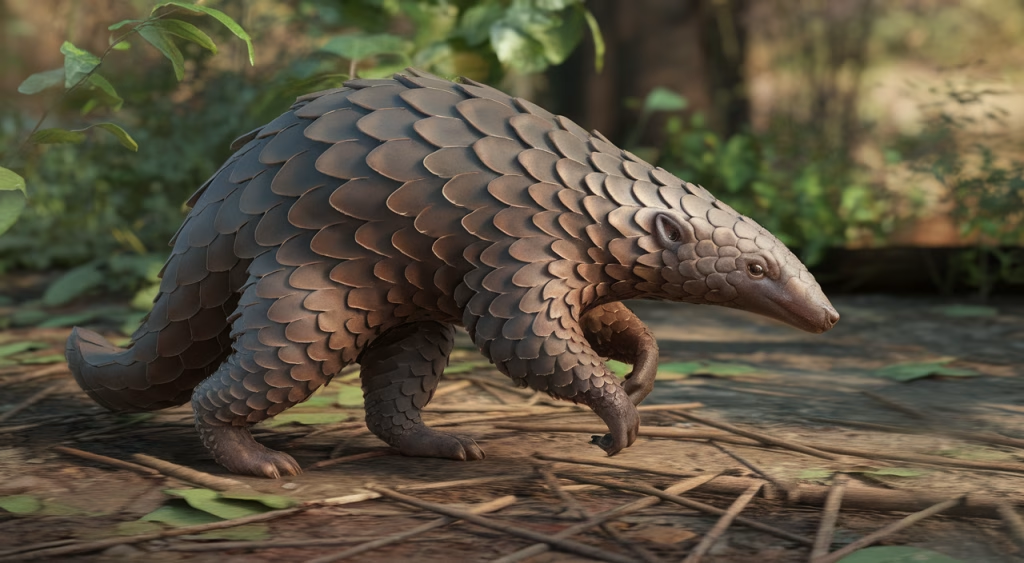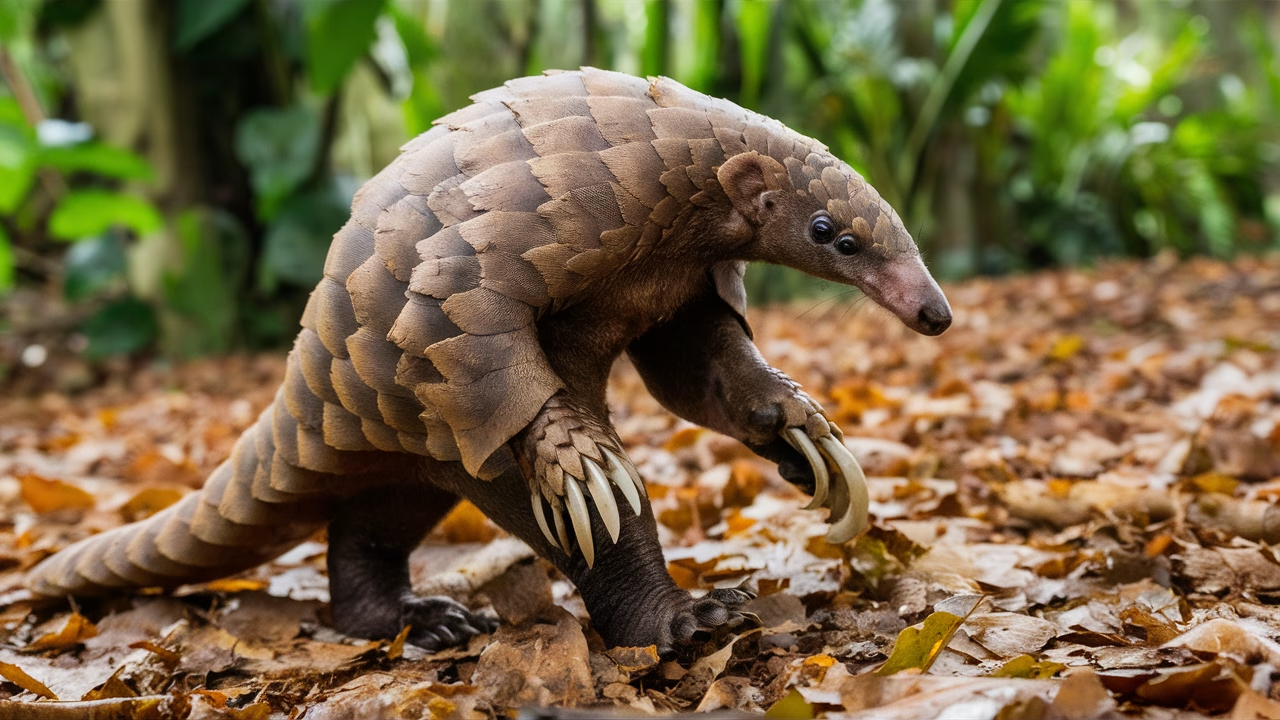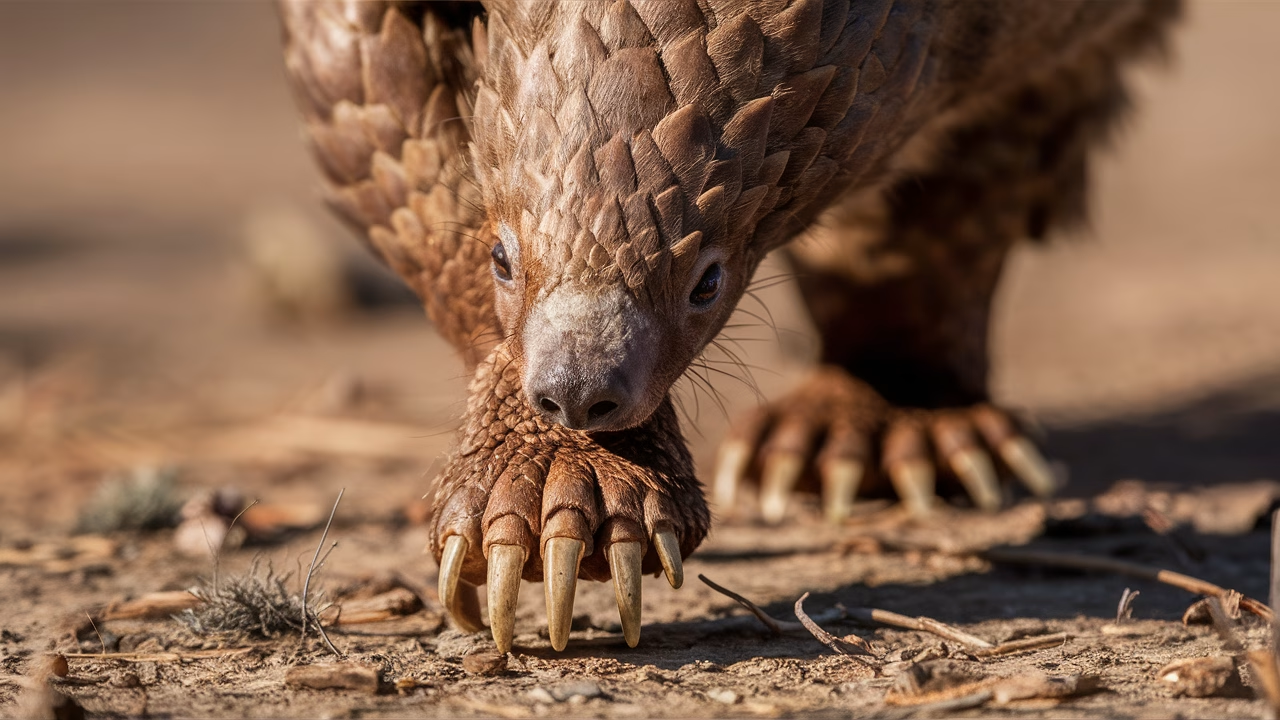Why Do Pangolins Walk on Their Knuckles?
Pangolins walk on their knuckles to protect their long, curved claws—their most essential survival tools. These razor-sharp claws are vital for accessing ants and termites hidden deep within mounds and rotting logs. Without proper **claw protection in pangolins**, these specialized tools would quickly dull or break if used for walking. **Knuckle-walking in pangolins** allows them to shield these precious instruments while navigating forest floors, savannas, and rocky terrain with remarkable efficiency.
TL;DR: Understanding Pangolin Knuckle-Walking
- Purpose: Helps preserve the integrity of their claws, which are crucial for digging into ant mounds and termite nests.
- Mechanics: Pangolins curl their claws under and walk on the backs of their front paws’ knuckles.
- Evolution: This behavior likely evolved due to ecological needs and anatomical constraints.
- Conservation: This special trait is an indicator of pangolin adaptation to their environment, now endangered by habitat loss and poaching.
- What to Remember: **Pangolin behavior** demonstrates how their unique walk is a clever solution tied deeply to their biology and survival needs.
Evolution of Knuckle-Walking in Pangolins
Ever watched a pangolin shuffle along the ground, its front feet curved under like a practiced acrobat tiptoeing across a tightrope? This isn’t just quirky movement—it’s the result of millions of years of evolutionary fine-tuning that answers **why pangolins walk on their knuckles**.
Let’s rewind to evolutionary motivations. Most mammals adapt their gait for speed, agility, or energy efficiency. For pangolins, it’s weapon preservation. Their forelimbs are armed with formidable claws—not for combat, but for cracking open insect nests, their primary food source. Traditional walking would grind down these claws, basically blunting their best defense against hunger.
So nature negotiated a brilliant compromise: keep the ultimate digging tools intact by folding them under during movement. This evolutionary quirk led to what we now recognize as **knuckle-walking in pangolins**, also seen (for different reasons) in gorillas and chimpanzees, though the evolutionary pathways are completely separate.
Unlike primates, pangolins aren’t built to climb or swing through trees via hand usage; they focus exclusively on burrowing and tearing into crevices. Evolution simply favored those individuals with the ability to carry sharp claws across distances without diminishing their effectiveness—a perfect example of **pangolin behavior** shaped by survival needs.
Mechanism Behind Claw Protection: How Pangolins Walk on Their Knuckles
You might wonder: what does a pangolin’s walk actually look like, and how does this **claw protection in pangolins** actually work?
Picture this: As a pangolin ambles over leaf litter, it carefully tucks its heavy claws under its ‘wrists’ and places weight on the sides or tops of its palms—much like a person on crutches, absorbing force away from delicate joints. This minimizes abrasion on the crucial claw tip while maintaining forward momentum.
Unlike bear or raccoon locomotion (flat-footed or ‘plantigrade’), **pangolins walk on their knuckles** using a modified quadrupedal gait. The hind feet remain flat but the front walk follows a semi-digitigrade, semi-bipedal configuration. Think ballerina on her knuckles—strange but purposeful.
This is where **claw protection in pangolins** becomes biomechanically elegant. Each step is strategic—preserving anatomical equity while minimizing pressure that could shear or split the claws. It also means they can maintain razor-sharp edges without frequent claw regeneration, conserving energy that would otherwise be spent on tissue remodeling. This efficiency is especially critical in pangolins, whose nutrient intake is already limited due to the relatively low caloric value of their ant and termite diet.
Adaptation to Habitat Loss: The Role of Knuckle-Walking
But here’s the concerning reality: habitats are disappearing rapidly, and with them, the ecological context that makes this **pangolin behavior** so effective.
**Knuckle-walking in pangolins**, as efficient as it is for dense forests or dry savannas, requires safe terrain. As deforestation fragments forests and hard-packed soil replaces soft leaf mulch, pangolins must walk further, work harder, and expose themselves to increased risk of injuries or predators.
In disturbed landscapes, such as converted farmland or mining areas, what was once a helpful trait can become a survival challenge. Rough concrete or gravel can still wear down claws even with knuckle-walking protection. Increased travel distances to find food sources can cause metabolic strain and dangerous exposure.
Recent studies on habitat loss and **pangolin behavior** suggest that pangolins in altered environments may change movement patterns—traveling at different times of day or altering foraging strategies entirely. But their gait remains genetically fixed; this **claw protection in pangolins** is hardwired into bone structure and tendon development.
This highlights the fragility of evolutionary adaptations. **Why pangolins walk on their knuckles** succeeds because of ecological harmony. Tamper with the ecosystem, and what was once ingenious can become inadequate for survival.
Conservation Efforts to Protect Pangolins
So what does this unique walking style have to do with conservation efforts? The connection is more significant than you might expect.
When illegal wildlife trade eliminates tens of thousands of pangolins annually, we’re not just losing individual animals. We’re losing millions of years of specialized evolution—including the remarkable biomechanical adaptation that explains **why pangolins walk on their knuckles**.
Global conservation efforts for pangolins now include comprehensive habitat protection, intensive anti-poaching patrols, and strengthening international laws against trafficking. But perhaps just as crucially, we need increased funding for research that monitors subtle behavioral indicators—like gait analysis.
Why does this matter? Because gait abnormalities observed in field footage can indicate whether pangolins are experiencing stress, malnutrition, or injury. In rehabilitation centers, proper observation of healthy **knuckle-walking in pangolins** helps determine when an animal is ready for release back into the wild.
| Conservation Focus | Impact on Knuckle-Walking |
|---|---|
| Reforestation Projects | Restores soft ground, reducing injury risk |
| Anti-Poaching Task Forces | Prevents trauma during trafficking |
| Wildlife Cameras | Tracks healthy vs abnormal gait |
| Public Awareness Campaigns | Protects species’ ecological legacy |
Ultimately, protecting a pangolin’s walk means protecting their entire world and preserving this incredible example of **pangolin behavior** for future generations.
Final Thoughts: What Can We Learn from a Pangolin’s Walk?
The fact that **pangolins walk on their knuckles** may seem like a small, even endearing detail—but it’s actually a window into their entire evolutionary story. Understanding **why pangolins walk on their knuckles** reveals a testament to the delicate harmony between anatomy and ecology, and demonstrates how fragile that balance truly is.
For anyone passionate about wildlife conservation, this unique **pangolin behavior** represents a call to value the subtle, the silent, and the extraordinary. Pangolins don’t roar like lions or charge like rhinos. Instead, they shuffle quietly and walk delicately on their knuckles—employing a gentle but potent survival strategy that offers profound lessons about adaptation, resilience, and our responsibility as stewards of biodiversity.
FAQs: Do Pangolins Walk on Their Knuckles?
- Do all pangolins walk on their knuckles? Yes, all eight pangolin species use knuckle-walking to protect their claws while moving across various terrains.
- Is pangolin knuckle-walking unique among mammals? While also seen in some primates, the specific purpose of claw protection makes **knuckle-walking in pangolins** functionally unique.
- How does their gait affect their lifestyle? This **pangolin behavior** limits maximum speed but enhances stealth and provides essential protection of their most important anatomical tools.
- Can knuckle-walking cause injury? In harsh terrains or inappropriate captive conditions, yes—which is why habitat preservation and proper care are critical.
- Can pangolins walk normally if injured? If their claws or limbs are damaged, their specialized walking becomes extremely difficult and potentially life-threatening.
- Why does walking behavior matter in conservation? **Claw protection in pangolins** and their gait offer early indicators of health status or environmental stress levels.
- Are captive pangolins affected in their walking behavior? Yes. Without adequate soft substrate flooring, they can develop joint pain or dangerous claw abnormalities that affect their natural movement.





